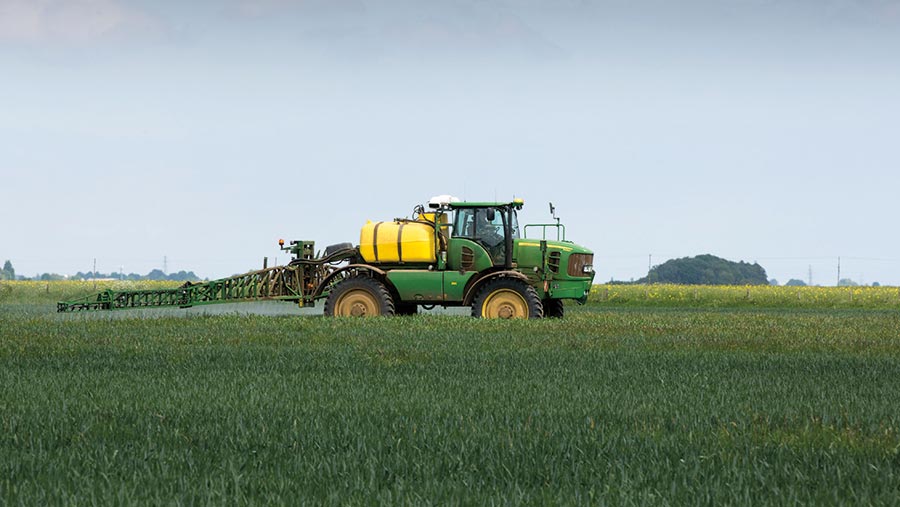How arable farmers can break the high-cost, low-yield cycle
 © Tim Scrivener
© Tim Scrivener Many arable businesses need to break the cycle of high costs, disappointing yields and low profits, says consultant Andersons.
Typical elements of the cycle include expanding to achieve economies of scale, taking short-term land at high rents, often at a distance from the main farm, running more and larger machinery as well as facing weed and soil fertility issues.
Extra land should be questioned as to whether it was actually contributing extra profit or just generating more work. Similarly, could poor areas be improved or would they be better off not cropped?
See also: Angus mixed farm trials undersown grass in spring barley
A focus on cost-effective production includes sustainable rotations, proportionate labour and machinery costs and careful selection of which land to crop, said Andersons head of business research, Richard King. “Some businesses have done a reassessment, downsized, and ended up more profitable and happier.”
Not many had done so because downsizing was often seen as some sort of failure but it should not be viewed as such, he said.
“The key is being able to reduce overhead costs in line with the new farmed area.
“Machinery is fairly easy as long as people are suitably clear-eyed about what is really necessary and what size.
“Labour can be a bit more tricky, but there’s usually some flexibility in just doing a bit less overtime.”
The outlook for the firm’s Loam Farm model, a 600ha combinable crop farm, shows an improvement for the 2017 harvest to give a positive farming margin before BPS of £38/ha, compared with a loss of £73/ha in the 2016 result.
However, this is almost entirely due to a favourable exchange rate and masks the underlying issues faced by many businesses – often a high cost base and disappointing yields, says the firm.
In an assessment of the Loam Farm Brexit outlook under ‘good’ and ‘bad’ access to EU markets, 2025 would bring a farming margin of £32/ha under good access, while poor access could lead to a negative margin of £32/ha.
Loam farm budgets (£/ha) |
||||
|
Harvest years |
2015 (result) |
2016 (provisional ) |
2017 (budget) |
2018 (budget) |
|
Output |
1,048 |
1,061 |
1,167 |
1,178 |
|
Less variable costs |
431 |
421 |
395 |
403 |
|
Gross margin |
617 |
640 |
772 |
775 |
|
Less overhead costs |
404 |
394 |
414 |
414 |
|
Less rent and finance |
243 |
242 |
243 |
243 |
|
Less drawings |
75 |
77 |
77 |
77 |
|
Farming margin |
(105) |
(73) |
38 |
41 |
|
BPS |
179 |
213 |
213 |
208 |
|
Business surplus |
74 |
140 |
251 |
249 |
|
Source: Andersons (Figures may not add up due to rounding) |
||||
The assumed large drop in rent and finance charges under these scenarios all comes from lower rents. “Based on the assumption that BPS flows through to rents, the drops in support reduce what’s being paid to landlords,” said Mr King.
“A 33% drop in subsidy equates to a 15% drop in rents. Where we’ve got a 66% drop (the Bad Access model), rents are assumed to fall by one-third.”
Much current farm management is based on carrying on as before, but Brexit does not stop people being able to focus on the things they can control – their own business performance, said Mr King.
Loam Farm and Brexit |
|||
|
Good access: Free trade agreement (FTA) with EU-27 Bad access: no EU deal but FTA with other countries, letting in low cost imports |
|||
|
£/ha |
2018 |
2025 (Good access) |
2025 (Bad access) |
|
Output |
1,178 |
1,162 |
1,045 |
|
Less variable costs |
403 |
420 |
419 |
|
Gross margin |
775 |
743 |
625 |
|
Less overhead costs |
414 |
425 |
428 |
|
rent and finance |
243 |
209 |
152 |
|
drawings |
77 |
77 |
77 |
|
Farming margin |
41 |
32 |
(32) |
|
Support |
208 |
139 |
71 |
|
Gross margin |
249 |
171 |
39 |
|
Source: Andersons (Figures may not add up due to rounding) |
|||
While environmental schemes were not suitable for everyone, they had been dismissed by many without really having been looked at properly, he said.
There was a risk that after Brexit there might be a gap in new schemes being offered while the new policies were being worked out.
